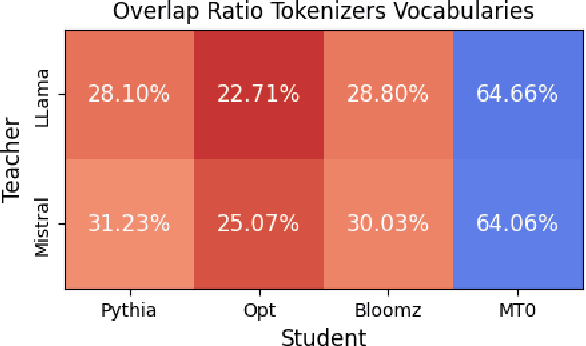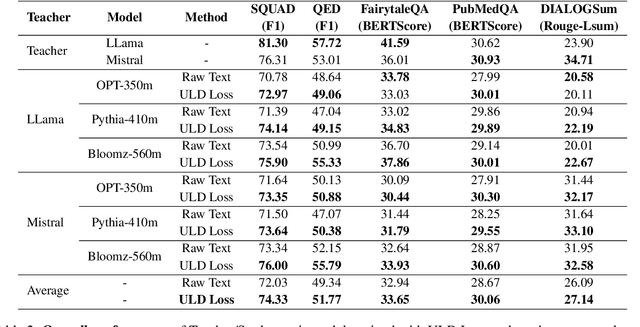Pierre Colombo
EuroBERT: Scaling Multilingual Encoders for European Languages
Mar 07, 2025Abstract:General-purpose multilingual vector representations, used in retrieval, regression and classification, are traditionally obtained from bidirectional encoder models. Despite their wide applicability, encoders have been recently overshadowed by advances in generative decoder-only models. However, many innovations driving this progress are not inherently tied to decoders. In this paper, we revisit the development of multilingual encoders through the lens of these advances, and introduce EuroBERT, a family of multilingual encoders covering European and widely spoken global languages. Our models outperform existing alternatives across a diverse range of tasks, spanning multilingual capabilities, mathematics, and coding, and natively supporting sequences of up to 8,192 tokens. We also examine the design decisions behind EuroBERT, offering insights into our dataset composition and training pipeline. We publicly release the EuroBERT models, including intermediate training checkpoints, together with our training framework.
Is Preference Alignment Always the Best Option to Enhance LLM-Based Translation? An Empirical Analysis
Sep 30, 2024Abstract:Neural metrics for machine translation (MT) evaluation have become increasingly prominent due to their superior correlation with human judgments compared to traditional lexical metrics. Researchers have therefore utilized neural metrics through quality-informed decoding strategies, achieving better results than likelihood-based methods. With the rise of Large Language Models (LLMs), preference-based alignment techniques have gained attention for their potential to enhance translation quality by optimizing model weights directly on preferences induced by quality estimators. This study focuses on Contrastive Preference Optimization (CPO) and conducts extensive experiments to evaluate the impact of preference-based alignment on translation quality. Our findings indicate that while CPO consistently outperforms Supervised Fine-Tuning (SFT) on high-quality data with regard to the alignment metric, it may lead to instability across downstream evaluation metrics, particularly between neural and lexical ones. Additionally, we demonstrate that relying solely on the base model for generating candidate translations achieves performance comparable to using multiple external systems, while ensuring better consistency across downstream metrics.
EuroLLM: Multilingual Language Models for Europe
Sep 24, 2024Abstract:The quality of open-weight LLMs has seen significant improvement, yet they remain predominantly focused on English. In this paper, we introduce the EuroLLM project, aimed at developing a suite of open-weight multilingual LLMs capable of understanding and generating text in all official European Union languages, as well as several additional relevant languages. We outline the progress made to date, detailing our data collection and filtering process, the development of scaling laws, the creation of our multilingual tokenizer, and the data mix and modeling configurations. Additionally, we release our initial models: EuroLLM-1.7B and EuroLLM-1.7B-Instruct and report their performance on multilingual general benchmarks and machine translation.
SaulLM-54B & SaulLM-141B: Scaling Up Domain Adaptation for the Legal Domain
Jul 28, 2024Abstract:In this paper, we introduce SaulLM-54B and SaulLM-141B, two large language models (LLMs) tailored for the legal sector. These models, which feature architectures of 54 billion and 141 billion parameters, respectively, are based on the Mixtral architecture. The development of SaulLM-54B and SaulLM-141B is guided by large-scale domain adaptation, divided into three strategies: (1) the exploitation of continued pretraining involving a base corpus that includes over 540 billion of legal tokens, (2) the implementation of a specialized legal instruction-following protocol, and (3) the alignment of model outputs with human preferences in legal interpretations. The integration of synthetically generated data in the second and third steps enhances the models' capabilities in interpreting and processing legal texts, effectively reaching state-of-the-art performance and outperforming previous open-source models on LegalBench-Instruct. This work explores the trade-offs involved in domain-specific adaptation at this scale, offering insights that may inform future studies on domain adaptation using strong decoder models. Building upon SaulLM-7B, this study refines the approach to produce an LLM better equipped for legal tasks. We are releasing base, instruct, and aligned versions on top of SaulLM-54B and SaulLM-141B under the MIT License to facilitate reuse and collaborative research.
ColPali: Efficient Document Retrieval with Vision Language Models
Jul 02, 2024Abstract:Documents are visually rich structures that convey information through text, as well as tables, figures, page layouts, or fonts. While modern document retrieval systems exhibit strong performance on query-to-text matching, they struggle to exploit visual cues efficiently, hindering their performance on practical document retrieval applications such as Retrieval Augmented Generation. To benchmark current systems on visually rich document retrieval, we introduce the Visual Document Retrieval Benchmark ViDoRe, composed of various page-level retrieving tasks spanning multiple domains, languages, and settings. The inherent shortcomings of modern systems motivate the introduction of a new retrieval model architecture, ColPali, which leverages the document understanding capabilities of recent Vision Language Models to produce high-quality contextualized embeddings solely from images of document pages. Combined with a late interaction matching mechanism, ColPali largely outperforms modern document retrieval pipelines while being drastically faster and end-to-end trainable.
SaulLM-7B: A pioneering Large Language Model for Law
Mar 07, 2024Abstract:In this paper, we introduce SaulLM-7B, a large language model (LLM) tailored for the legal domain. With 7 billion parameters, SaulLM-7B is the first LLM designed explicitly for legal text comprehension and generation. Leveraging the Mistral 7B architecture as its foundation, SaulLM-7B is trained on an English legal corpus of over 30 billion tokens. SaulLM-7B exhibits state-of-the-art proficiency in understanding and processing legal documents. Additionally, we present a novel instructional fine-tuning method that leverages legal datasets to further enhance SaulLM-7B's performance in legal tasks. SaulLM-7B is released under the MIT License.
Tower: An Open Multilingual Large Language Model for Translation-Related Tasks
Feb 27, 2024



Abstract:While general-purpose large language models (LLMs) demonstrate proficiency on multiple tasks within the domain of translation, approaches based on open LLMs are competitive only when specializing on a single task. In this paper, we propose a recipe for tailoring LLMs to multiple tasks present in translation workflows. We perform continued pretraining on a multilingual mixture of monolingual and parallel data, creating TowerBase, followed by finetuning on instructions relevant for translation processes, creating TowerInstruct. Our final model surpasses open alternatives on several tasks relevant to translation workflows and is competitive with general-purpose closed LLMs. To facilitate future research, we release the Tower models, our specialization dataset, an evaluation framework for LLMs focusing on the translation ecosystem, and a collection of model generations, including ours, on our benchmark.
Towards Trustworthy Reranking: A Simple yet Effective Abstention Mechanism
Feb 22, 2024Abstract:Neural Information Retrieval (NIR) has significantly improved upon heuristic-based IR systems. Yet, failures remain frequent, the models used often being unable to retrieve documents relevant to the user's query. We address this challenge by proposing a lightweight abstention mechanism tailored for real-world constraints, with particular emphasis placed on the reranking phase. We introduce a protocol for evaluating abstention strategies in a black-box scenario, demonstrating their efficacy, and propose a simple yet effective data-driven mechanism. We provide open-source code for experiment replication and abstention implementation, fostering wider adoption and application in diverse contexts.
Towards Cross-Tokenizer Distillation: the Universal Logit Distillation Loss for LLMs
Feb 20, 2024



Abstract:Deploying large language models (LLMs) of several billion parameters can be impractical in most industrial use cases due to constraints such as cost, latency limitations, and hardware accessibility. Knowledge distillation (KD) offers a solution by compressing knowledge from resource-intensive large models to smaller ones. Various strategies exist, some relying on the text generated by the teacher model and optionally utilizing his logits to enhance learning. However, these methods based on logits often require both teacher and student models to share the same tokenizer, limiting their applicability across different LLM families. In this paper, we introduce Universal Logit Distillation (ULD) loss, grounded in optimal transport, to address this limitation. Our experimental results demonstrate the effectiveness of ULD loss in enabling distillation across models with different architectures and tokenizers, paving the way to a more widespread use of distillation techniques.
Enhanced Hallucination Detection in Neural Machine Translation through Simple Detector Aggregation
Feb 20, 2024Abstract:Hallucinated translations pose significant threats and safety concerns when it comes to the practical deployment of machine translation systems. Previous research works have identified that detectors exhibit complementary performance different detectors excel at detecting different types of hallucinations. In this paper, we propose to address the limitations of individual detectors by combining them and introducing a straightforward method for aggregating multiple detectors. Our results demonstrate the efficacy of our aggregated detector, providing a promising step towards evermore reliable machine translation systems.
 Add to Chrome
Add to Chrome Add to Firefox
Add to Firefox Add to Edge
Add to Edge